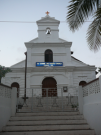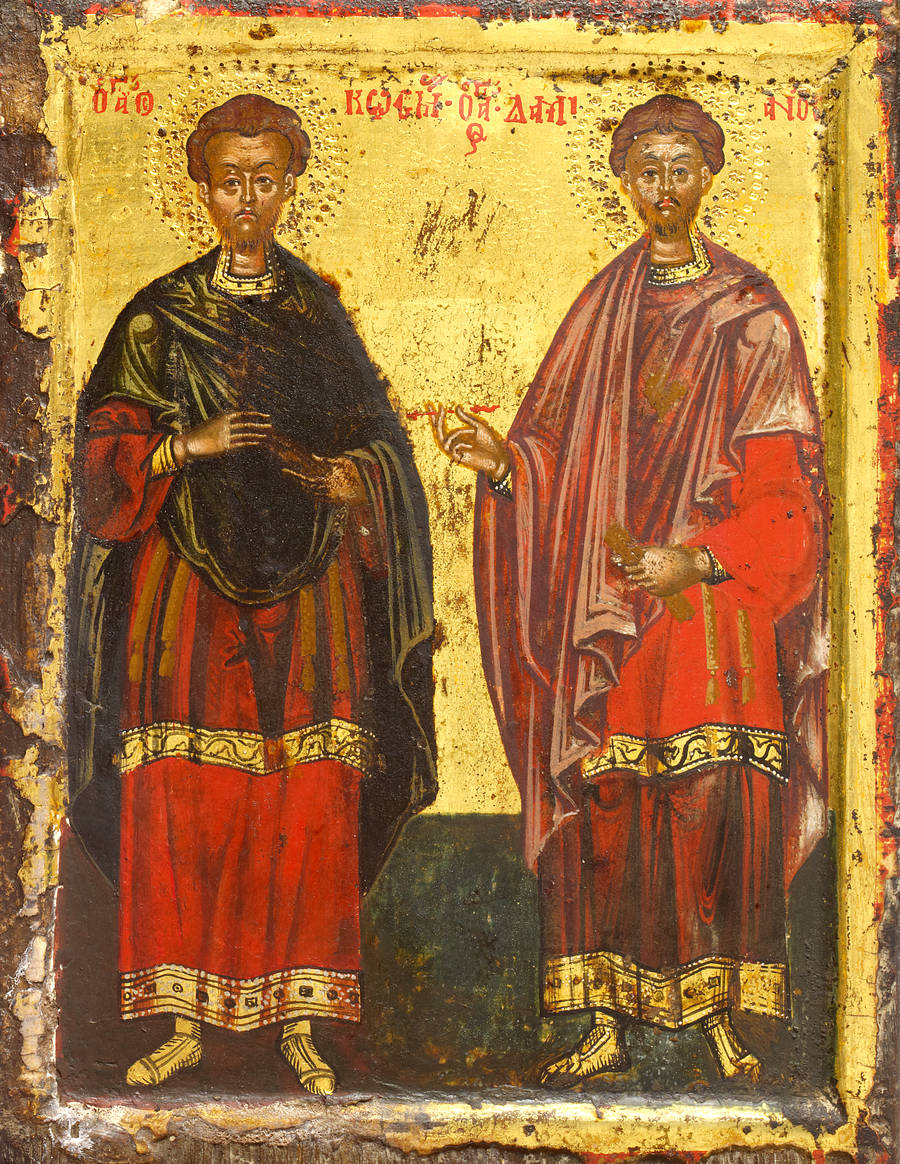
St. Cosmas and St. Damian

St. Cosmas and St. Damian (Greek: Κοσμάς και Δαμιανός, Kosmás kai Damianós; Latin: Cosmas et Damianus; died c. AD 287) were reputed twin brothers, physicians, and early Christian martyrs. They practiced their profession in the seaport of Aegeae, then in the Roman province of Syria.
Accepting no payment for their services led St. Cosmas and St. Damian being named Anarguroi (Ανάργυροι, “Unmercenaries“); it has been said that, by this, they attracted many to the Christian faith.
Nothing is known of the lives of St. Cosmas and St. Damian except that they suffered martyrdom in Syria during the persecution of the Emperor Diocletian. According to Christian traditions, the twin brothers, St. Cosmas and St. Damian were born in Arabia and became skilled doctors. Saladino d’Ascoli, a 15th century Italian physician, claims that the medieval electuary known as opopira, a complex compound medicine used to treat diverse maladies including paralysis, was invented by St. Cosmas and St. Damian. During the persecution under Diocletian, St. Cosmas and St. Damian were arrested by order of the Prefect of Cilicia, one Lysias who is otherwise unknown, who ordered them under torture to recant. However, according to legend they stayed true to their faith, enduring being hung on a cross, stoned and shot by arrows and finally suffered execution by beheading. Anthimus, Leontius and Euprepius, their younger brothers, who were inseparable from them throughout life, shared in their martyrdom.
St. Cosmas and St. Damian most famous miraculous exploit was the grafting of a leg from a recently deceased Ethiopian to replace a patient’s ulcered or cancerous leg, and was the subject of many paintings and illuminations.
As early as the 4th century, churches dedicated to the twin saints were established at Jerusalem, in Egypt and in Mesopotamia. Devotion to the two saints spread rapidly in both East and West. Theodoret records the division of their reputed relics. Their relics, deemed miraculous, were buried in the city of Cyrrus in Syria. Churches were built in their honor by Archbishop Proclus and by Emperor Justinian I (527–565), who sumptuously restored the city of Cyrus and dedicated it to the twins, but brought their purported relics to Constantinople; there, following his cure, ascribed to the intercession of Cosmas and Damian, Justinian, in gratitude also built and adorned their church at Constantinople, and it became a celebrated place of pilgrimage. At Rome Pope Felix IV (526–530) rededicated the Library of Peace (Bibliotheca Pacis) as a basilica of Santi Cosma e Damiano in the Forum of Vespasian in their honour. The church is much rebuilt but still famed for its sixth-century mosaics illustrating the saints.
What are said to be their skulls are venerated in the convent of the Clares in Madrid, where they have been since 1581, the gift of Maria, daughter of Emperor Charles V. They had previously been removed from Rome to Bremen in the tenth century, and thence to Bamberg. Other skulls said to be theirs were discovered in 1334 by Burchard Grelle, Archbishop of Bremen. He “personally ‘miraculously’ retrieved the relics of the holy physicians Cosmas and Damian, which were allegedly immured and forgotten in the choir of the Bremen Cathedral. In celebration of the retrieval Archbishop and Chapter arranged a feast at Pentecost 1335, when the relics were translated from the wall to a more dignified place.[9] Grelle claimed the relics were those Archbishop Adaldag brought from Rome in 965. The cathedral master-builder Johann Hemeling made a shrine for the relics, which was finished around 1420. The shrine,made from carved oak wood covered with gilt and rolled silver is considered an important mediaeval gold work. In 1649 Bremen’s Chapter, Lutheran by this time, sold the shrine without the heads to Maximilian I of Bavaria. The two heads remained in Bremen and came into the possession of the small Roman Catholic community. They were shown from 1934 to 1968 in the Church of St. Johann and in 1994 they were buried in the crypt. The shrine is now shown in the Jesuit church of St Michael in Munich. At least since 1413 another supposed pair of skulls of the saints has been stored in St Stephens’s Cathedral in Vienna. Other relics are claimed by the Church of San Giorgio Maggiore in Venice.
The martyr twins are invoked in the Canon of the Mass in the prayer known as the Communicantes (from the first Latin word of the prayer): “In communion with the whole Church, they venerate above all others the memory of the glorious ever-virgin Mary, Mother of our God and Lord, Jesus Christ, then of blessed Joseph, husband of the Virgin, your blessed Apostles and Martyrs, Peter and Paul, Andrew, James, …John and Paul, Cosmas and Damian and all your Saints: grant through their merits and prayers that in all things we may be defended by the help of your protection.” They are also invoked in the Litany of the Saints, and in the older form of the Roman rite, in the Collect for Thursday in the Third Week of Lent, as the station church for this day is Santi Cosma e Damiano.
Their feast day in the General Roman Calendar, which had been on September 27, was moved in 1969 to September 26, because September 27 is the dies natalis (“day of birth” into Heaven) of Saint Vincent de Paul, now more widely venerated in the Latin Church.
Sts Cosmas and Damian are regarded as the patrons of physicians and surgeons and are sometimes represented with medical emblems.
In Brazil, the twin saints are regarded as protectors of children, and September 27 is commemorated, especially in Rio de Janeiro, by giving children bags of candy with the saints’ effigy printed on them and throughout the entire state of Bahia where Catholics and adepts of Candomblé religion offer typical food such as carurú. The ritual consists of first offering the food to seven children that are no older than seven years old and then having them feast while sitting on the floor and eating with their hands. Only after all children have finished can the guests enjoy the food that is being offered. The Church of Saints Cosmas and Damian, in Igarassu, Pernambuco is Brazil’s oldest church, built in 1535.
In the UK St Damian is the dexter side supporter in the coat of arms of the British Dental Association.
Sts. Cosmas & Damian are venerated every year in Utica, New York at St. Anthony’s Parish during the annual pilgrimage which takes place on the last weekend of September (close to the Sept. 27 feast day). There are thousands of pilgrims who come to honor the saints. Over 80 busloads come from Canada and other destinations. The 2-day festival includes music (La Banda Rosa), much Italian food, masses and processions through the streets of East Utica. It is one of the largest festivals honoring saints in the northeast USA.